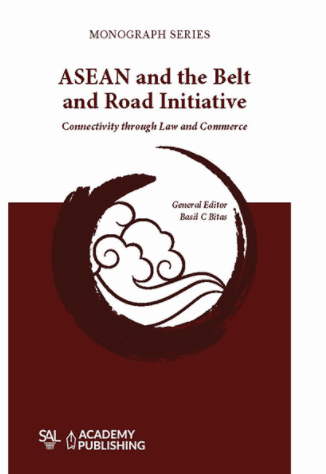Asean And Bri: Opportunities For The Legal World

The following is an excerpt from the forthcoming ASEAN and the Belt and Road Initiative: Connectivity through Law and Commerce, published by Academy Publishing. This book highlights the range of interdisciplinary expertise and applied skills, whether of a legal, commercial, financial or operational nature, required to bring the BRI and its defining projects to fruition while setting them within a broader economic and geopolitical frame. Its general editor, Mr Basil Bitas, is a member of the Bars of New York State and Washington, DC and a former Associate Professor (Practice) at the Singapore Management University’s School of Law. Order the title here.
The BRI, launched by Chinese President Xi Jinping in Kazakhstan in September 2013, has the potential to change the economic and geopolitical landscape for years to come. Like the 1955 Bandung Conference of Non-Aligned Nations, the BRI is often cast as a watershed development, a moment when Asia, writ large, came of age in an assertive and constructive posture, embodying the hopes of a better life for humanity. Stretching from the South China Sea across the Eurasian land mass to Europe, the BRI contemplates a new era of frictionless trade and connectivity. Completed by the Maritime Silk Road Initiative announced in Indonesia in October 2013, the BRI as a whole lays out a vision of connectivity encompassing the traditional overland Silk Road, now known as the Silk Road Economic Belt, and the complementary maritime component to form the Belt and Road, linking Asia, Southeast Asia, parts of Africa, and Europe into a contiguous zone of commerce.
The BRI is further comprised of six economic corridors, including the Bangladesh-China-Myanmar Corridor and the China-Indochina Peninsula Corridor, both of particular interest to Southeast Asia, and the China-Pakistan Economic Corridor noteworthy for the sheer size and financial scope of the projects contained therein. The six corridors essentially link the northern-oriented overland “Economic Belt” to the southern-oriented Maritime Silk Road by forming a series of “straps” between the two.
The vision is unprecedented in scope and unique in approach. The world today has various models of regional co-operation, reflected most prominently in the highly formalistic European Union (“EU”) and the looser, less legalistic model reflected in ASEAN. The Belt and Road contemplates a third variant, inviting countries to coalesce around interests rather than geography per se and to focus on operational criteria rather than formalistic legal structures and obligations. If ASEAN pioneered the notion of open regionalism, the BRI constitutes an invitation for open economic development. It is presented as an open platform to which any country can align itself in the service of connectivity, frictionless trade, and global economic development.
Thus the BRI is at once ambitious and somewhat amorphous. It is perhaps this combination that results in the BRI’s aspirational power. It reflects a compelling vision, which participating countries are largely free to frame and access as they see fit. The challenge moving forward will be for China and participating countries to give the BRI form and substance. Thus far, there is no overarching Belt and Road Treaty or other similar founding document. Rather, there are a growing number of bilateral memoranda of understanding with participating countries, outlining various forms of co-operation under the Belt and Road umbrella. Such undertakings are given further substance by the vast array of Belt and Road infrastructure projects undertaken across Southeast Asia, South Asia, Central Europe and across the Eurasian land mass to Europe.
At this point, it is estimated that roughly 75 countries actively participate in the BRI “network” with infrastructure projects extending or otherwise touching upon some 125 countries even if some of these are not viewed as Belt and Road participants per se. The original Belt and Road concept has been further buttressed by a proposal for a Polar Silk Road stretching to the Arctic region. Underscoring the all-encompassing nature of the Belt and Road concept and its emphasis on connectivity in the pure sense is a companion proposal for a Digital Silk Road (“DSR”), a topic which will be dealt with in detail in this volume. The BRI also includes a proposal for a “Health Silk Road”, an area of increasing urgency in light of the COVID-19 pandemic.
From this capsule summary of the BRI, three conclusions can be drawn: (a) it is unique in scope; (b) it is evolving; and (c) it has the potential to generate great good, but remains amorphous both in terms of its geographic coverage and concrete execution. These characteristics, defining a powerful but still somewhat ill-defined idea, have led some to characterise the BRI as a “brand” rather than a defined development programme per se. As noted, such a description can have a positive connotation, highlighting the BRI’s aspirational power. However, it also hints at some of the criticisms levelled at the BRI as a “marketing” ploy aimed at extending China’s geopolitical influence, both regionally and globally, in the absence of a clear plan as to how the BRI will yield collective development benefits.
Thus, the notions of “debt traps” as exemplified by the star-crossed development of the Hambantota Port in Sri Lanka and the controversy surrounding the financing of the East Coast Rail Link in Malaysia have come to dominate or at least inform the debate concerning the Belt and Road and its potential attributes. Among other active BRI jurisdictions, a recent study highlights Djibouti, the Maldives, the Lao People’s Democratic Republic (“Lao PDR”), Montenegro, Mongolia, Tajikistan, the Kyrgyz Republic and Pakistan as jurisdictions becoming increasingly susceptible to the “debt trap” scenario.
Notwithstanding the negative publicity, the controversy actually creates a singular opportunity for participating countries and their professional representatives to reshape the BRI, so that it achieves its full potential as a vehicle for regional and global economic development. Moreover, China itself seems to have recognised the deficiencies in its early approach as reflected in the Joint Communique of the Leaders’ Roundtable of the 2nd Belt and Road Forum for International Cooperation issued in Beijing on 27 April 2019. Point 6 of the Communique is particularly instructive:
Looking into the future, we envisage high-quality Belt and Road cooperation in enhancing connectivity by promoting development policy synergy, infrastructure development, unimpeded trade, financial cooperation and people-to-people bond, thereby enhancing practical cooperation for the well-being of our peoples. In this context, we look forward to more efforts by cooperation partners.
- Such cooperation will be based on extensive consultation, joint efforts, shared and mutual benefits. We emphasize the importance of the rule of law and equal opportunities for all.
- Such cooperation will be open, green and clean.
- Such cooperation will pursue high standard, people-centered and sustainable development.
The above reflects significant self-awareness on the part of the Chinese government that some type of mid-course correction is required. The sub-points capture key elements of the modern transnational investment environment, including transparency, sustainability, and good governance. As noted, such an emphasis opens the door to professionals in participating countries, including those active in the legal, finance, insurance, infrastructure and sustainability fields, to pool their resources and expertise to realise the BRI’s full potential. It also explains the interdisciplinary focus of this volume. The scope of the BRI’s ambitions and the size of the associated infrastructure projects require professionals in various fields to appreciate their roles as parts of an integrated, collective effort. The BRI has been described as multilateral in spirit, but bilateral in execution. However, such a characterisation belies the fact that the professional services needed to support BRI projects will require both interdisciplinary and interjurisdictional co-operation. As an example, it is estimated that 33 per cent of China’ outbound BRI investments are channelled through Singapore, thereby demonstrating the broad scope for providing professional services. Thus, while a given project may appear bilateral in nature as a deal between China and a given host country, the provision of professional services may depend upon a far more complex international network of co-operation. It is, in part, the goal of this volume to raise the awareness of concerned professionals of these opportunities and to outline the related expertise required to take advantage of them in a commercially astute manner.
The above is an excerpt from the forthcoming ASEAN and the Belt and Road Initiative: Connectivity through Law and Commerce, published by Academy Publishing. This book highlights the range of interdisciplinary expertise and applied skills, whether of a legal, commercial, financial or operational nature, required to bring the BRI and its defining projects to fruition while setting them within a broader economic and geopolitical frame. Its general editor, Mr Basil Bitas, is a member of the Bars of New York State and Washington, DC and a former Associate Professor (Practice) at the Singapore Management University’s School of Law. Order the title here.

